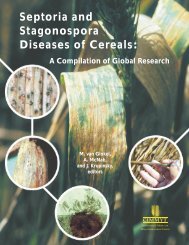Section 3 (Crop Management)
Section 3 (Crop Management)
Section 3 (Crop Management)
You also want an ePaper? Increase the reach of your titles
YUMPU automatically turns print PDFs into web optimized ePapers that Google loves.
Maize in the rice-wheat rotation<br />
Availability of multi-crop zero-till-cum bed planter, a ’combine’ for the alternate practical and<br />
sustainable tillage practices, is a possibility for farmers to practice the intercropping with much ease. The<br />
split seed box attached with this machine facilitate simultaneous sowing of two or more crops in a single<br />
operation, and still maintains the respective seed rates. This machine can sow in both zero-till and bed<br />
planting situations.<br />
Maize sector in IGP in general and in India in particular is in transition and is expanding (Morris et<br />
al., 1998). Fuelled by changing food habits and increasing marketing opportunities, this is the time for<br />
further expansion and promoting maize further in rice-wheat rotation through above discussed crop<br />
diversification options. Some of the favorable indications towards this shift are appearing in Uttar Pradesh<br />
where the kharif maize is replacing the rice crop (Gupta, Personal Observation, 2003).<br />
Challenges Ahead<br />
Zero-till establishment of wheat after a successful kharif maize crop is expected to face problems<br />
related to seeding owing to the hard, undecomposed maize stubs and dry soil. The newly developed zerotill<br />
drill fitted with double disk type pre-openers, can sow through the rice straw. This should be further<br />
tested for its utility in such conditions. In all probability, the draft energy requirement is going to be<br />
higher in the above conditions. To add to this, the relatively dry maize harvested field might even need a<br />
pre-sowing/post sowing irrigation for sowing and proper field emergence of subsequent crop. Agrotechniques<br />
need to be standardized for proper establishment of zero-till maize for wider and easy<br />
adoption.<br />
Inclusion of maize in rice-wheat rotation will increase the demand for better maize germplasm which<br />
need to be met through policy changes for increased access to these germplasm. Measures are also<br />
required to make available good quality seed of appropriate varieties. Expansion of market and industrial<br />
process facilities must also commensurate with the increasing maize production. Farmers should benefit<br />
more by producing maize by getting good market price for their produce.<br />
Conclusion<br />
Inclusion of maize in rice-wheat growing areas is a useful proposition. Ongoing efforts with<br />
alternative crop establishment methods and cropping systems proved successful. With bed planting, the<br />
crop intensification and diversification is sure to change the way the crop is grown in these areas.<br />
Resource use efficiency can be improved and nutritional and income security can be achieved with little<br />
more efforts in solving some of the challenges mentioned in this paper. It needs a change in mind-set of<br />
farmers towards the way the crops are raised and it might call for radical changes which are possible<br />
through linking research and farmers in a harmonious way.<br />
- 209 -









